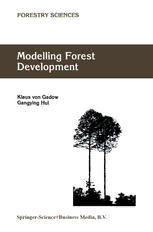Table Of ContentMODELLING FOREST DEVELOPMENT
FORESTRY SCIENCES
Volume 57
Modelling Forest
Development
VON GADOW
Forest Sciences and Woodland Ecology,
Germany
HUI
of Forest Sciences,
KLUWER ACADEMIC PUBLISHERS
DORDRECHT/BOSTON/LONDON
A C.I.P. Catalogue record for this book is available from the Library of Congress.
ISBN 0-7923-5488-5
Published by Kluwer Academic Publishers,
P.O. Box 17, 3300 AA Dordrecht, The Netherlands
Sold and distributed in North, Central and South America
by Kluwer Academic Publishers,
101 Philip Drive, Norwell, MA 02061, U.S.A.
In all other countries, sold and distributed
by Kluwer Academic Publishers,
P.O. Box 322, 3300 AH Dordrecht, The Netherlands
Printed on acid-free paper
All Rights reserved
©1999 Kluwer Academic Publishers
No part of the material protected by this copyright notice may be reproduced or
utilized in any form or by any means, electronic or mechanical,
including photocopying, recording or by any information storage and
retrieval system, without written permission from the copyright owner.
Contents
1 Introduction
1
Types of Forest Models 3
Data Requirements 6
Permanent Plots 9
Temporary Plots 11
Interval Plots 12
2 Projecting Regional Timber Resources
15
Empirical Yield Functions 16
Fully Stocked Forests 17
Non-fully Stocked Forests 21
Yield Functions based on MAl Estimates 23
3 Modelling Stand Development
26
Height 26
Anamorphic Height Models 28
Disjoint Polymorphic Height Models 31
Non-Disjoint Polymorphic Height Models 36
Basal Area 39
Potential Density 42
The Limiting Line 43
Estimating Potential Density 44
Natural Decline of Stem Number 46
State-Space Models 47
Stand Volume and Product Yields 50
Thinning Models 53
vi
Classical Description of Thinning Operations 54
Thinning Weight 57
Type of Thinning 59
4 Size Class Models
61
Diameter Growth 62
Projecting Diameter Distributions 63
Stand Table Projection 67
Diameter Growth as a Function of Diameter 68
Growth Modifiers 70
Change of Relative Basal Area 75
A Worked Example 77
Transition Matrices 79
Diameter-Height Relations 83
Generalized Diameter-Height Relations 83
Bivariate Diameter-Height Distributions 86
Estimating Product Yields 92
Volume Ratio Methods 93
Modelling Stem Profiles: Form Quotients, Splines and 94
Polynomials
Parameter-parsimonious Stem Profile Functions 96
Generalized Stem Profile Functions 100
Stem Quality Assessment and Prediction 103
Modelling Thinnings 109
Change of Distribution Parameters 109
Movement of the Diameter Distribution after Thinning 114
Separation Parameters 116
Modelling Foresters' Tree Selection Behaviour 121
5 Individual Tree Growth
129
Generating Spatial Structures 130
vii
Variables for describing Spatial Structure 131
Size Differentiation 132
Species Segregation and Mingling 133
Aggregation 137
Using Structural Variables to generate Positions with Attributes 140
Competition Indices 143
Overlapping Influence Zones 145
Distance-weighted Size Ratios 148
Available Growing Space 151
Shading and Constriction 153
Spatial Growth Models 159
FOREST, PROGNAUS and MOSES 160
SILVA 165
Spatial Thinning Models 168
Imitation 168
Prescription 175
6 Model Evaluation
181
Qualitative Evaluations 181
Quantitative Evaluations 185
Characterizing Model Error 185
Statistical Tests 189
List of Symbols
191
Literature
195
Index
205
Acknowledgements
The compilation of the material included in this book, which gradually developed
as a result of our mutual interest in quantitative aspects of forest modelling, was
completed during a sabbatical period at the newly established Campus of the
University of Santiago de Compostela, the Escola Polit(knica Superior in Lugo.
Lugo is one of the four provincial capitals of Galicia in northern Spain, which is
possibly the most productive timber growing area in Europe. The generous
hospitality and support of our friends in Lugo, including those of the medical
profession, is gratefully acknowledged.
Comments received from Dr. Harold Burkhart are gratefully acknowledged.
Dr. Jiirgen Nagel of the Niedersachsische Forstliche Versuchsanstalt and
Matthias Albert and Hendrik Heydecke of the Institut fur Forsteinrichtung und
Ertragskunde, University of Gottingen, helped us develop some of the algorithms
and examples. Sonja Rudiger assisted with the graphs and, together with Jeanne
Wirkner and Marga von Gadow, did the major part of the proofreading.
The modelling applications are not limited to a specific geographical region
or system of forest management. We have made an attempt to include examples
from different countries in Europe, Asia, North America and Africa, covering
even-aged plantation forestry as well as uneven mixed forests managed in the
selection system. Several of the growth models presented in this text were
developed using data sets provided by the Academy of Forestry in Beijing/China.
We were also able to use stem data collected by the Niedersachsische Forstliche
Versuchsanstalt in Gottingen for fitting taper equations.
Klaus v. Gadow Gangying Hui
Chapter One
Introduction
In an lUlffianaged woodland, forest development follows a succession of periods
of undisturbed natural growth, interrupted by intermediate loss or damage of
trees caused by fire or wind or other natural hazards. In a managed woodland,
the most important periodic disturbances are the thinning operations, which are
often carried out at regular intervals and which usually have a significant effect
on the future evolution of the resource. Thus, a realistic model of forest
development includes both natural growth and thinnings.
The key to successful timber management is a proper understanding of
growth processes, and one of the objectives of modelling forest development is
to provide the tools that enable foresters to compare alternative silvicultural
treatments. Foresters need to be able to anticipate the consequences of a
particular thinning operation. In most cases, total timber volume is not a very
appropriate measure for quantifying growth or yields, or changes caused by
thinning operations. Yield in economic terms is defined by the dimensions and
quality attributes of the harvestable logs, and estimating timber products is a
central issue of production-oriented growth and yield research.

